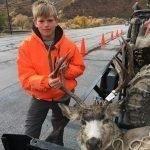DWR Press Release
Rifle deer hunt runs through Oct. 28
A little snow likely made a big difference during the opening weekend of Utah’s general rifle buck deer hunt. In some areas, snow and colder temperatures pushed deer out of the high country and towards their lower elevation wintering areas.
The hunt, which started Oct. 20, runs until Oct. 28.
Northeastern Utah
Randall Thacker, assistant wildlife manager in the Division of Wildlife Resources’ Northeastern Region, said snow storms in northeastern Utah pushed deer out of the high country and into areas where hunters had an easier time getting to them.
“We’ve had a really good hunt,” Thacker said on the morning of Oct. 23. “Hunters were seeing deer and getting shots.”
The number of deer brought through a voluntary DWR check station off U.S. Highway 40 near Strawberry Reservoir was almost identical to last year. Only 30% of the deer checked were yearlings. The rest—70%—were mature deer, many of them more than 3½ years old. “We saw some big, healthy bucks,” Thacker said.
The number of deer that came through the two remaining check stations in northeastern Utah was even more impressive. DWR biologist Amy Vande Voort had her hands full at the check station near Manila: the number of deer brought through the station doubled from last year. At the Steinaker check station north of Vernal, DWR biologist Clint Sampson saw a 20% increase in the number of deer brought through his station.
“Most of the deer that came through the two stations were younger animals,” Thacker said, “but it was impressive to see an increase in the number of deer checked.”
Northern and North-central Utah
A hot, dry summer left many biologists thinking success might be lower during the rifle hunt this fall. DWR Central Region Wildlife Manager Riley Peck said snow and colder temperatures before the hunt might have saved the day in north-central Utah.
“It’s been a pretty normal hunt,” Peck said. “I think snow in the high country has helped push deer around a bit, and hunters are finding decent success.”
Peck said the number of deer checked at DWR check stations in the region was almost identical to 2017. For example, at the agency’s busiest check station in Spanish Fork Canyon, a total of 178 deer were checked from Saturday through Monday. In 2017, a total of 171 deer were checked over the same three-day period.
Randy Wood, wildlife manager in the Northern Region, saw a similar situation in northern Utah. He said 121 deer were checked at four stations on Saturday and Sunday. In 2017, a total of 167 deer were checked. He said check stations were set up in a different part of the region last fall, though, so an exact comparison between 2017 and 2018 is hard to make.
“Overall,” Wood said, “I think the opener was good.” He said a mix of ages—31% yearling, 26% 2 years old and 43% 3½ years of age and older—were checked at stations in northern Utah.
A difference Wood noticed was less hunter crowding. About 20% of the permits in the region were set aside for an early rifle hunt held Oct. 10 – 14 on four units in the region.
“The hunters and the DWR conservation officers I visited with said the same thing: it seemed to be less crowded out there,” Wood said.
Southern Utah
The toughest hunting was in southern Utah. On Saturday, DWR biologists set a station up to check hunters coming off the LaSal and Abajo mountains in southeastern Utah. Guy Wallace, wildlife manager in the Southeastern Region, said the number of deer brought through the station from Saturday through Monday was down 50% from 2017.
“I think snow in the high country got the deer moving and scattered them a bit,” he said. “It might take a few days for hunters to find them.”
Wallace also said the number of fawns was down in 2017, and he expects hunters to take fewer 1½-year-old bucks this fall. “It’ll be interesting to see how the overall hunt turns out,” he said.
In south-central and southwestern Utah, Southern Region Wildlife Manager Teresa Griffin reported similar results: the number of deer brought through check stations in the region was down an average of 50% from what it’s been over the past few years.
“Most of the deer look healthy,” she said, “but, because of the drought, their antlers weren’t quite as big as they’d normally be.”
As part of a research project, several deer on the Pine Valley unit have been fitted with radio collars. On Monday, about 60% of the deer were on their winter range, while 30% were in transitional zones and 10% were still hanging out in their summer range.
“The deer migration seems to be spread out right now,” Griffin said, “and that might have contributed to lower success rates over the weekend.”
Griffin said an abundance of acorns, and water from recent rain storms, is likely the reason deer are spread across so many different areas. “Snow that fell two weeks ago likely got the deer moving, but it warmed back up, and the deer might have paused a little to take advantage of the warmth,” she said. “In some areas, there was almost a little green up after the storm that came through on Oct. 6 and 7.”
Additionally, an early rifle hunt was held Oct. 10 – 14 on several units in the region. The early hunt reduced the number of hunters in the field during the regular hunt.
“Fewer hunters afield might have also contributed to fewer deer coming through the check stations over the weekend,” she said.
- This is Devin Allen’s first deer. He took the big buck in north-central Utah.
- This young hunter had a successful hunt in northeastern Utah.



